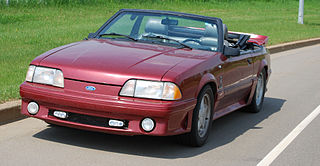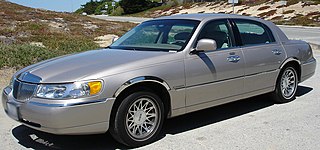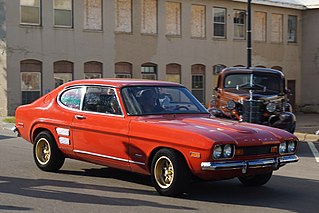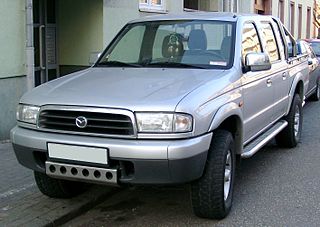History
Blakely Auto was founded by Dick Blakely to market affordable sports cars in the spirit of the legendary Lotus Seven: compact, lightweight, and with excellent handling. [1] The Bantam was Blakely's first offering. It was followed by the larger Bearcat and eventually by the Bernardi.
The founder had a degree in mechanical engineering and had been involved in oval track racing prior to designing the Bantam. His goal with the initial design was to maximize performance while minimizing size, weight, accessories, and other features that might conflict with acceleration and handling. Blakely took inspiration from an early model of the British Dutton Cars, itself a Lotus Seven replica. [2] After building the first car for himself, Blakely found sufficient interest from other auto enthusiasts to warrant building more cars of the same design. Partnering with Denny Myelle, Blakely began to produce the Bantam as a kit and also to develop a new, larger car that was more versatile and suited to off-track use. This second model became the Bearcat and later developed into the Bernardi.
For both models, a key design goal was use of a single donor automobile. Designs based on a single donor simplify the build process. The car Blakely selected was the Ford Pinto, with the option to use parts from close relatives like the Mercury Bobcat and the Ford Mustang. This family of donor vehicles gave the Blakely cars rack-and-pinion steering, front disk brakes, and a good selection of engine choices. For the chassis, Blakely Auto provided a frame of box steel tubing, custom front upper A-arms for the suspension, new shocks, and instructions for modifying and attaching the remaining chassis components from the donor car. Blakely Auto also supplied a full replacement body, including the body tub, doors, hood, fenders, trunk, convertible or hard top, and windshield.
Around 1979, ownership of the company transferred to Art Herschberger. [3] In the Spring of 1979 he moved production from Davis Junction, Illinois to Princeton, Wisconsin. [4] The early 1980s saw development and production of the Bernardi, a significant modification of the Bearcat model. In 1985, the company was renamed the Bernardi Auto Works. [5] The business appears to have shut down in the late 1980s. Blakely automobiles still appear for sale in various specialist auto markets, but no new ones are being manufactured.

The Ford GT40 is a high-performance endurance racing car designed and built by the Ford Motor Company. It grew out of the "Ford GT" project, an effort to compete in European long-distance sports car races, against Ferrari, who had won the prestigious 24 Hours of Le Mans race from 1960 to 1965. Ford succeeded with the GT40, winning the 1966 through 1969 races.

The Lotus Seven is a small, simple, lightweight, two-seater, open-top, open-wheel, sports car produced by the British manufacturer Lotus Cars between 1957 and 1972.

A kit car is an automobile available as a set of parts that a manufacturer sells and the buyer then assembles into a functioning car. Usually, many of the major mechanical systems such as the engine and transmission are sourced from donor vehicles or purchased new from other vendors. Kits vary in completeness, consisting of as little as a book of plans, or as much as a complete set with all components to assemble into a fully operational vehicle such as those from Caterham.

The Ford Mustang is a series of American automobiles manufactured by Ford. In continuous production since 1964, the Mustang is currently the longest-produced Ford car nameplate. Currently in its sixth generation, it is the fifth-best selling Ford car nameplate. The namesake of the "pony car" automobile segment, the Mustang was developed as a highly styled line of sporty coupes and convertibles derived from existing model lines, initially distinguished by "long hood, short deck" proportions.

Pony car is an American car classification for affordable, compact, highly styled coupés or convertibles with a "sporty" or performance-oriented image. Common characteristics include rear-wheel drive, a long hood, a short decklid, a wide range of options to individualize each car and use of mass-produced parts shared with other models.

The Ford Fox platform is an automobile platform that was used by Ford Motor Company. Introduced for compact sedans in the 1978 model year, the Fox architecture was utilized for a wide variety of configurations for Ford and Lincoln-Mercury vehicles. In its original form, the platform was used through the 1993 model year; a substantial redesign of the Ford Mustang extended its life into the 21st century, ending production in 2004. Produced across 26 model years, the Fox platform is the second-longest car architecture ever designed by Ford Motor Company.

The Ford Panther platform was an automobile platform that was used by Ford Motor Company from the 1979 to 2012 model years. Following the downsizing of the General Motors B-bodies and C-bodies by two years, the Panther platform marked the end of production of sedans unencumbered by downsizing. Originally slated for discontinuation during the early 1980s, the Panther architecture was used for 33 model years, the longest-produced platform in North American automotive history.

Capri is a nameplate marketed by the Lincoln-Mercury division of Ford Motor Company on three distinct series of automobiles between 1970 and 1994.

Robin Hood Engineering Ltd was a British kit car manufacturer based in Mansfield Woodhouse, Nottinghamshire. The factory covered 30,000 square feet (2,800 m2) and was on a one and a half acre site.

The Mazda B series is a series of pickup trucks that was manufactured by Mazda. Produced across five generations from 1961 to 2006, the model line began life primarily as a commercial vehicle, slotted above a kei truck in size. Through its production, Mazda used engine displacement to determine model designations; a B1500 was fitted with a 1.5 L engine and a B2600, a 2.6 L engine.

Locust is a kit car inspired by the Lotus Seven. It was first developed in the mid 1980s as a cheap kit car to be built onto the chassis of a Triumph Spitfire, it was later developed into a full kit car which used its own fully designed ladder chassis - unlike others using space frame. The car was famed for its cheap to build construction using MDF in the body, the last kits were produced in early 2000.

The Continental Mark VI is a full-size luxury car that was produced by Ford Motor Company from 1980 to 1983. The fifth generation of the Mark series, the Continental Mark VI introduced several changes to the model line. Again marketed and serviced by the Lincoln-Mercury division, the Mark VI served as the flagship of the entire Ford Motor Company model line, slotted above the Lincoln Town Car.
Dutton Cars, based in Worthing, Sussex, England, was a maker of kit cars between 1970 and 1989. In terms of number of kits produced, it was the largest kit-car manufacturer in the world.

The Lincoln MKR concept car was a premium 4-door fastback sedan design, as introduced during the 2007 North American International Auto Show by Lincoln. Its chassis was based on the Ford D2C platform as used in the Ford Mustang. The MKR signaled the next-generation of premium Lincoln vehicles, introducing the new TwinForce engine family and a restyled "bow wave" waterfall grill. The concept car was first unveiled to the media and the public in a press release on 1 January 2007.
Factory Five Racing, Inc. (F.F.R.) is an American automobile company that designs and manufactures assembly kits, chassis, bodies and related components for replicars and sports cars.
Fiberfab was an American automotive manufacturer established in 1964. Starting with accessories and body parts, they progressed to making kit cars and fully assembled automobiles. They became one of the longest lasting kit car manufacturers.

The Blakely Bernardi is an automobile produced in the 1980s by Blakely Auto Works of Princeton, Wisconsin, USA. Blakely produced a number of automobile models, including the Bearcat and Bantam. This model is named after Enrico Bernardi, Italian inventor of the gasoline internal-combustion engine and automobile pioneer. The Bernardi was available as a completed car or as a kit of parts to be assembled by the buyer.

The first-generation Ford Mustang was manufactured by Ford from March 1964 until 1973. The introduction of the Mustang created a new class of automobiles known as the pony cars. The Mustang’s styling, with its long hood and short deck, proved wildly popular and inspired a host of competition.
The Blakely Bantam was a kit car produced by Blakely Auto Works, a manufacturer of kit cars located in a series of US midwest communities in the 1970s and 1980s. Blakely Auto was founded by Dick Blakely to market affordable sports cars in the spirit of the legendary Lotus Seven: compact, lightweight, and with excellent handling. The Bantam's design inspiration was the Dutton, a Lotus Seven replica built in Britain. The Bantam was introduced in 1972 as Blakely's first offering, followed by the larger Bearcat and eventually by the Bernardi. Production of the Bantam continued into the 1980s, when the model was renamed the Hawk, and stopped with the dissolution of Bernardi Auto Works in the later 1980s.
The Ginetta G26 and its derivatives, the 'G28, G30, and G31, are a series of two-door sports cars, designed, developed, and manufactured by British company Ginetta, from 1984 to 1992, primarily in kit form. All models are based on Ford mechanical components. They differ in length as well as in different bodies and engines. All variants together, about 360 vehicles were built in eight years.















